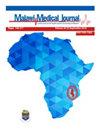Epidemiological, anatomopathological and immunohistochemical profiles of male breast cancer in Sidi Bel Abbes, Algeria (Profiles of male breast cancer)
IF 1.2
4区 医学
Q4 PUBLIC, ENVIRONMENTAL & OCCUPATIONAL HEALTH
引用次数: 0
Abstract
Background Male breast cancer (BC) is a rare disease, few prospective studies have been undertaken compared to studies carried out in women. The condition is characterised by unfavorable prognosis when compared to that of females. The aim of the present work is to describe the anatomopathologic characteristics of males breast cancer at the level of the pathology department of the Hospital-University Center of Sidi Bel Abbes (ALGERIA).MethodsA descriptive cross-sectional study on male breast cancers diagnosed in our pathology department between January 2010 and December 2020 was undertaken, the variables assessed were epidemiological, macroscopic, microscopic and immunohistochemical data. Results A total of 25 breast male cancer were identified in this study, the mean age at the diagnosis time was 58.8± 3.5 years, and the age was ranging from 37 to 83. The mean tumor size was 3.58 ± 1.5 cm, with sizeranging from 1.8 to 9 cm. About 18 of patients had tumors located in the upper outer quadrant (UOQ). Histopathological examination revealed the predominance of invasive carcinoma of no special type in 22 patients, followed by lobular carcinoma in 2 patients. 18 patients presented with nodal involvement and 23 of patients had hormonal receptors expression, including oestrogen receptor (RO), and progesterone receptor (RP). Additionnaly, just one patient had positive overexpression of HER2 (human epidermal growth factor receptor 2).ConclusionBreast cancer in males in Algeria appears to be relatively rare and presents at an older age compared to females. Three out of four patients presented tumors in the UOQ and most were invasive carcinoma no special type. In the majority of male BC cases hormonal receptors and nodal involvement were present, while HER2 receptors were absent.阿尔及利亚 Sidi Bel Abbes 地区男性乳腺癌的流行病学、解剖病理学和免疫组化概况(男性乳腺癌概况)
背景男性乳腺癌(BC)是一种罕见疾病,与针对女性的研究相比,前瞻性研究很少。与女性相比,男性乳腺癌的预后较差。本研究旨在描述西迪贝勒阿巴斯医院大学中心病理科(阿尔及利亚)男性乳腺癌的解剖病理学特征。方法 对 2010 年 1 月至 2020 年 12 月期间在病理科确诊的男性乳腺癌进行描述性横断面研究,评估变量包括流行病学、宏观、微观和免疫组化数据。结果 本研究共发现 25 例男性乳腺癌,确诊时的平均年龄为(58.8± 3.5)岁,年龄在 37 至 83 岁之间。肿瘤平均大小为(3.58±1.5)厘米,大小范围为 1.8 至 9 厘米。约18名患者的肿瘤位于外上象限(UOQ)。组织病理学检查显示,22 名患者的肿瘤以无特殊类型的浸润癌为主,2 名患者的肿瘤为小叶癌。18 名患者有结节受累,23 名患者有激素受体表达,包括雌激素受体(RO)和孕酮受体(RP)。此外,只有一名患者的 HER2(人表皮生长因子受体 2)呈阳性过表达。四名患者中有三人的肿瘤位于上腹部,大多数为浸润性癌,无特殊类型。在大多数男性乳腺癌病例中,存在激素受体和结节受累,而不存在 HER2 受体。
本文章由计算机程序翻译,如有差异,请以英文原文为准。
求助全文
约1分钟内获得全文
求助全文
来源期刊

Malawi Medical Journal
Medicine-General Medicine
CiteScore
1.50
自引率
0.00%
发文量
27
审稿时长
>12 weeks
期刊介绍:
Driven and guided by the priorities articulated in the Malawi National Health Research Agenda, the Malawi Medical Journal publishes original research, short reports, case reports, viewpoints, insightful editorials and commentaries that are of high quality, informative and applicable to the Malawian and sub-Saharan Africa regions. Our particular interest is to publish evidence-based research that impacts and informs national health policies and medical practice in Malawi and the broader region.
Topics covered in the journal include, but are not limited to:
- Communicable diseases (HIV and AIDS, Malaria, TB, etc.)
- Non-communicable diseases (Cardiovascular diseases, cancer, diabetes, etc.)
- Sexual and Reproductive Health (Adolescent health, education, pregnancy and abortion, STDs and HIV and AIDS, etc.)
- Mental health
- Environmental health
- Nutrition
- Health systems and health policy (Leadership, ethics, and governance)
- Community systems strengthening research
- Injury, trauma, and surgical disorders
 求助内容:
求助内容: 应助结果提醒方式:
应助结果提醒方式:


